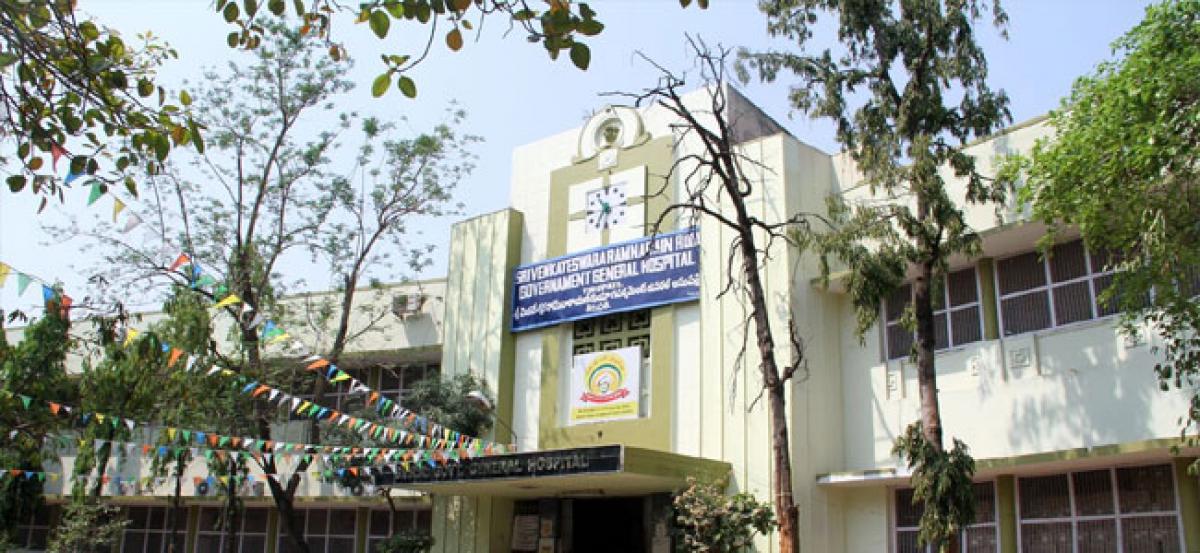Live
- Record additions in non-fossil fuel energy in India
- Indian teens’ grand arrival on world stage
- Chanchalguda Jail Officials Say They Haven't Received Bail Papers Yet, Allu Arjun May Stay in Jail Tonight
- BJP leaders present evidence of illegal voters in Delhi, urge EC for swift action
- Exams will not be cancelled: BPSC chairman
- Nagesh Trophy: Karnataka, T.N win in Group A; Bihar, Rajasthan triumph in Group B
- YS Jagan condemns the arrest of Allu Arjun
- Economic and digital corridors to maritime connectivity, India and Italy building vision for future, says Italian Ambassador
- SMAT 2024: Patidar's heroics guide Madhya Pradesh to final after 13 years
- CCPA issues notices to 17 entities for violating direct selling rules
Just In

The incidence of cancer, which is currently around 70-90 cases per one lakh population, likely to rise 4,000-6,000 cases in Chittoor district if the government shows negligence in dealing with the life-threatening disease.
Tirupati: The incidence of cancer, which is currently around 70-90 cases per one lakh population, likely to rise 4,000-6,000 cases in Chittoor district if the government shows negligence in dealing with the life-threatening disease. With the lack of proper treatment facilities at government hospitals, the patients in Chittoor and its neighbouring districts are being forced to move other states for better medical care.
Highlights:
- Cancer affected are depending on other states due to lack of facilities in government hospitals
- Majority cancer patients are discontinuing treatment due to financial reasons
It was learnt that more than 60 per cent of cancer patients require radiotherapy as a curative procedure or sometimes as a palliative procedure to relieve symptoms and also in oncological emergencies.
A government doctor on condition of anonymity said that, roughly 60-80 cancer cases per month were being referred to other hospitals for treatment, as there was no provision at Ruia Government Hospital in Tirupati. He said that most of the cancer patients were suffering either without treatment or discontinuing it due to financial reasons and lack of specialised services.
As per guidelines of the Intersociety Council for Radiation Oncology, USA, 1 lakh population should have one linear accelerator popularly known as radiotherapy machine for better qualitative radiotherapy treatment for cancer patients. In view of the disease burden in India, National Cancer Control programme is insisting for oncology unit especially radiotherapy unit in every teaching hospital as a measure.
But for about 40 lakh population in the district, there were only three radiotherapy machines–2 in SVIMS and another on in a private hospital. In fact, the oncology unit was there in Ruia Hospital till sometime back.
The government’s apathy in providing required infrastructure, staff and other vital equipment makes the department non-functional and it don’t have even a building now.
Ruia Hospital Superintendent Dr B Sidda Naik maintained that administrative sanctions were completed for the proposed building and once it is completed out-patient wing can be started. Though SVIMS was having a full-fledged cancer wing with its Director himself is an oncologist, it could not meet the demand of patient load and having its own limitations in providing free services to all.
On the other hand, being a teaching hospital for 200 under graduates and equal number of post graduates, Ruia Hospital should have working radiotherapy unit as minimum requirement as per MCI regulations which was not being taken care of by the government. Radiation Oncologist Dr B Nehru of Ruia Hosptial said, “We are planning to start out-patient wing very soon at least with day care.
It is important to educate patients at the initial stages to take proper care, which can save them from going into advanced stages of the disease. In stage-1, it is curable, and they can lead normal life”. He said, in most of the cases among rural women, cervical cancer was the main problem though there are incidence of breast cancer and oral cancer too.
Reasons for more cervical cancer cases may be attributed to viral infections, unhygienic conditions and having multiple sex partners. Increased use of tobacco was resulting in oral cancers. The District Medical and Health Officer (DM&HO) Dr S Vijaya Gowri said that, every woman aged 30 plus being compulsorily screened in their respective PHCs for breast, cervical and oral cancer symptoms. Only basic screening is available in PHCs and if any symptoms are found they will be advised to go for further treatment.

© 2024 Hyderabad Media House Limited/The Hans India. All rights reserved. Powered by hocalwire.com







